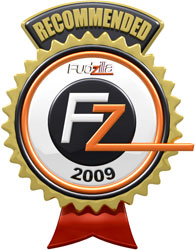Index


Review: XFX Radeon HD5770, HD5750 and HD5850 round-up
Nvidia's Fermi may have diverted some attention from AMD's launch of Evergreen line, but AMD has been far from idle. As you probably know, the company has been the first to deliver a DX11 card in the shape of HD 5870 and HD 5850, and is now ready to deliver another blow with the HD 5770 and HD 5750. Of course, all Evergreen-series cards come with DX11 support, meaning that AMD is locked and loaded waiting for the new Windows, which should launch next week.
Just like the currently top Evergreen product, the Cypress-based HD5870, the new graphics cards are made in 40nm and come with GDDR5 memory. Furthermore, the cards feature ATI Stream, UVD2 and Eyefinity support. It's well worth noting that AMD uses 128-bit bus for its mainstream models, but using fast GDDR5 memory compensates and provides enough bandwidth.
XFX has been kind enough to send us both 5700 series cards as well as an HD 5850, so we'll begin the talk of the new cards with one of our today's test samples, the XFX HD5850, which will help us shed some light on AMD's Evergreen generation.
The HD 5850
The HD 5850 is based on AMD's Cypress LE GPU running at 725MHz and has 1440 stream processors opposed to 1600 stream processors on the Cypress XT GPU (HD 5870). It is positioned below the HD 5870 but promise to deliver a much better bang per buck as it is priced lower without sacrificing performance too much. Both Cypress cards are high-end cards, and the only card that will top their performance is Hemlock, the dual GPU card we're expecting by the end of the year.
The memory on HD 5850 runs at 1000MHz (GDDR5 4000MHz) but it has much more bandwith compared to mainstrame HD5700 cards, thanks to the 256-bit memory interface. The HD 5850's GPU sports 72 texture units and just like the HD 5870, it features 32 ROPs. Unlike the 5700 generation cards, which are powered via one 6-pin connector, the HD 5870 and HD 5850 require two 6-pin connectors.
XFX sent us a reference clocked HD 5850 with reference, dual-slot cooling. Rest assured though that it won't take long for XFX to come out with an overclocked version, as these guys are rarely wasting time. The card comes with a coupon for the full game Dirt 2.
This game comes with DX11 support, and what you'll see within the game was done using HW Tessellation: DynamicWater Surface , HW Tessellation: Dynamic Cloth, HW Tessellation: Animated Crowd, DirectCompute11: Optimize Post Processing Effects, ShaderModel5.0: High Quality Shadow Filtering and ShaderModel5.0: Depth of Field. The game looks seriously nice so it's well worth giving it a go.
The pricetag on the XFX HD 5850 is about 210 euro, which is pretty appealing considering what this card can do.
The HD 5700 series
The two new HD 5700 cards are performance-oriented mid-range cards with DirectX 11 and Crossfire Support. The HD 5770 is slightly slower than the HD 4870, whereas the slower Juniper HD 5750 is the HD 4850's successor. The HD 5750 will ship in 512MB and 1024MB versions and is priced at about $129 or 110 euro, so it will be somewhere around the HD 4870's price. The HD 5770 is set to go on sale for $159 at Newegg and about 130 euro in the EU, which is a bit more than the HD 4870. Unfortunately, some things never change and once again we see the planetary popular overcharge-the-Europeans tactics at work.
The HD 5750
The HD 5750 is based on AMD's Juniper LE GPU running at 700MHz and while its big brother, the HD 5870 features 1600 stream processors, the HD 5750's stream processor count is down to 720. The HD 5750's 1GB of GDDR5 memory runs at 1150MHz on a 128-bit bus and comes with 36 texture units and 16 ROPs, compared to the HD 5870's 80 texture units and 32 ROPs.
Although this is a crippled version of the Cypress chip, the new technologies are featured on manstream cards as well. Those who follow developments on the graphics market already know that this cards comes with Eyefinity technology, which allows for more than two monitors on one card, up to three. The HD 5750 features 2 dual-link DVI, HDMI and DisplayPort outputs, just like HD 5770 and other Cypress card. AMD used dual-slot cooling on this card, rendering it pretty quiet (pun intended). As we've said already, XFX stuck to the reference clocks on the first batch of cards to come out of the company.
The HD 5770
The HD 5770 is based on AMD's Juniper XE GPU running at 850MHz and it features 800 stream processors. The memory on HD 5770 cards is clocked at 1200MHz (GDDR5 efective 4800MHz). The card comes with 800 stream processors, which is half the amount the Cypress is capable of. The card's bandwidth is 76.8GB/s, slightly higher than on the HD 5750, which comes with 1150MHz memory and 73.6GB/s bandwidth.
The cards we recieved from XFX came with 1GB of GDDR5 memory but the HD 5750 will also be probably available in 512MB GDDR5 versions at a later date.
Note that all the cards we've recieved from XFX run at reference clocks, but that's still enough for serious gaming performance.
Features
So, AMD's Evergreen family of products lists GPUs codenamed Cedar, Redwood, Juniper, Cypress and Hemlock (the last GPU being the fastest). Furthermore, while the current crop of launched DX11 cards is single-GPU, rest assured that dual-GPU Hemlock cards aren't far away.
Of course, while developing Evergreen series AMD didn’t only focus its efforts towards improving performance, but paid attention to power consumption as well using ATI PowerPlay. As a matter of fact, AMD seems to have done a good job as the new 40nm architecture doesn't consume much more than the previous generation, while delivering superior performance.
Apart from ATI Eyefinity technology, all the chips come with ATI Stream support, which will when combined with compatible programs take some strain off of the CPU and put the GPU to good use.
It's worth repeating that the cards come with native Windows 7 support and that all the Evergreen cards are DirectX 11 ready. DirectX 11 brings quite a couple of important features, such as tesselation, which subdivides relatively low-polygon meshes into finer surfaces needed for more detailed objects such as faces or different terrains. The rest of the important features include Shader Model 5.0, Multi threading, HDR texture compression and DirectCompute.
AMD's cards come with OpenCL support and seem to offer only OpenGL 3.1. Yesterday, AMD launched the fourth beta of ATI Stream SDK v2.0 for the OpenCL 1.0 development platform. ATI Stream SDK passed the Khronos group's testing and runs stable with OpenCL 1.0. Applications created with OpenCL framework can be executed on heterogeneous platforms including the CPU, GPU and other processors.
As for the bandwidth, the 128-bit memory interface does introduce some limitations, but the GDDR5 partially compensated for this, whereas the HD5800 generation comes with a 256-bit interface. Of course, 1GB of memory is almost a prerequisite for any comfortable gaming at higher resolutions.
Those who're more interested in video out capabilities should know that the cards come with HDMI 1.3 support with Deep Color, 7.1 High Bitrate Audio as well as on-chip HDCP support.
XFX's current offer includes all the so-far launched Evergreen cards, but our today's test is reserved for mainstream and cheaper high-end cards. Of course, we're talking about XFX Radeon HD 5850, XFX Radeon HD 5770 and XFX Radeon HD 5750, the last card being the slowest. The pollowing picture takes us to the world of DirectX 11 cards, marketed by XFX under the slogan "Expand, Accelerate, Dominate".
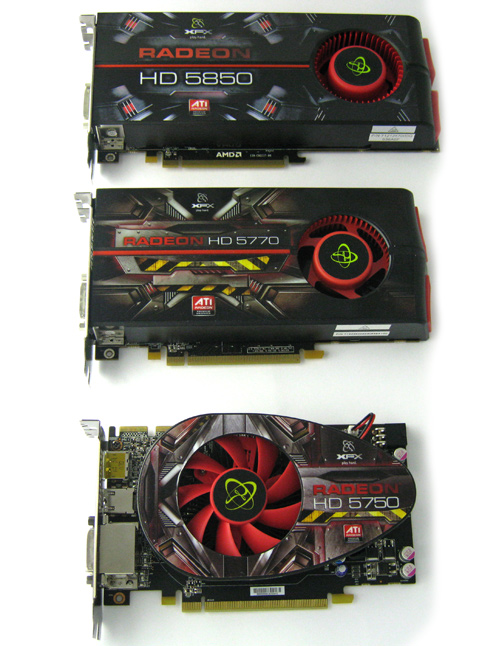
All the cards come with the same dual-slot cooling and identical configuration of outs on the I/O panel. As you already know, Eyefinity allows for up to three monitors, but gaming at high resolutions will be a task for the HD5850, whereas the other two mainstream cards are more appropriate for resolutions up to 1920x1200.
XFX Radeon HD 5750
While the HD 5770 differs from the HD 5850 only by the size of the actual card, the HD 5750 comes with different, bug-like dual-slot cooling, which runs pretty quiet. The new 40nm GPU doesn't require much power and runs cooler, so the card won't require better cooling solutions found on the faster models. The XFX HD 5750 card is 18.5cm long, which is about 2/3 size of the Cypress HD 5870 card.

XFX uses a black PCB for its cards, and the cooler fits the design nicely with its red and black color scheme. The card is powered via one 6-pin power connector.
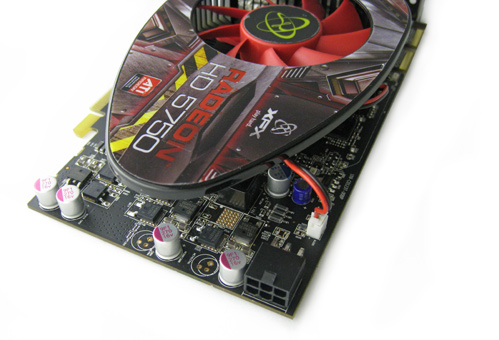
The card comes with 1GB of GDDR5 distributed evenly on the front and the back of the card. As you can see from the picture, the cooling isn't in direct contact with the memory.
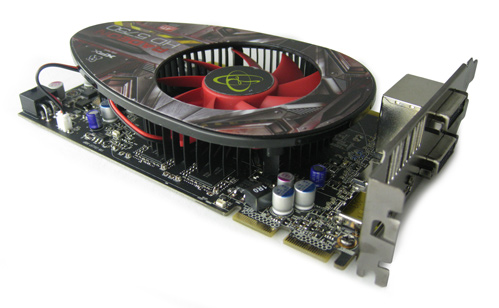
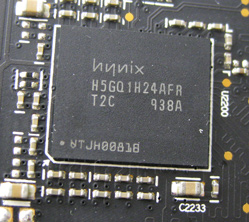
The I/O panel features two Dual-Link DVI outs, one HDMI out and a DisplayPort connector. A careful observer will notice that all three of our todays cards feature the same bracket and the same configuration of outs.
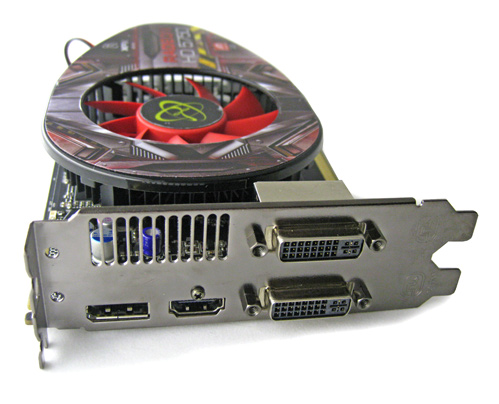
Crossfire performance scaling is getting better with each model, and this card supports it as well.
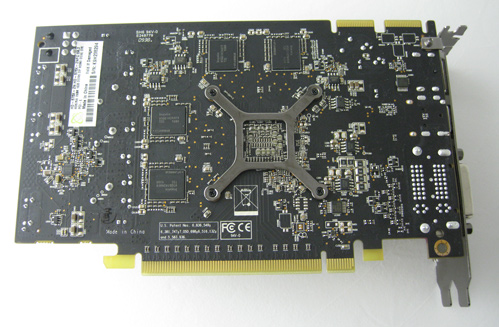
XFX HD 5770
The XFX HD 5770 runs at reference clocks - 850MHz GPU and 1200MHz memory. Although the memory interface is 128-bit, pairing it up with GDDR5 results in bandwidth of 76.8GB/s. Unlike the HD 4870 which required two 6-pin connectors, the HD 5770 requires only one. Maximum consumption won't exceed 108W, whereas idle consumption stays at 18W. For comparison, the XFX HD 5750 consumes up to 86W in workload scenarios.
The following photo shows the XFX HD 5770, which looks-wise resembles the faster, HD 5800 series' cards.
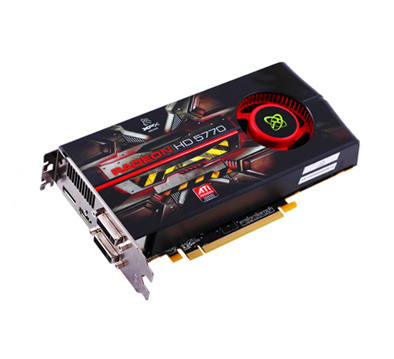
Just like on the HD 5750, the HD 5770's memory is evenly distributed (4 modules on the front and on the back). The memory again comes from Hynix.
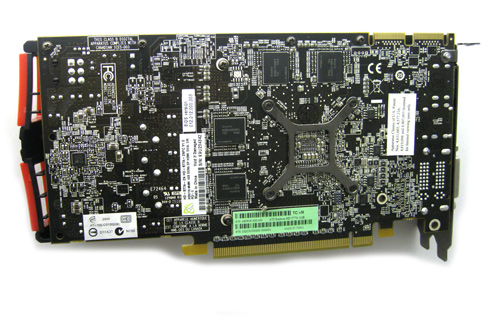
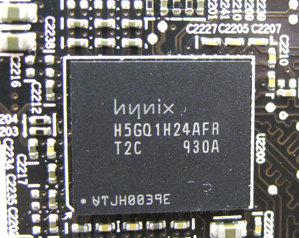
The XFX HD 5770's dual-slot cooling features a fan towards the end of the card, which pushes hot air towards the I/O panel and out of the case. However, since the video outs take up a lot of space, the outlets are pretty small so some air surely escapes through the card's hood. The card proudly bears the ATI Radeon logo, and you can clearly see some additional air outlets on the photos.
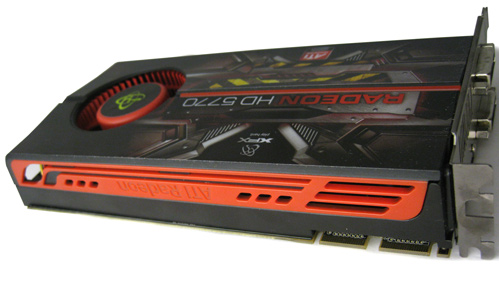
The power connector is hidden in towards the end of the card. We already said that the HD 5770 won't consume more than 108W, so PCI-Express power coupled with an additional 6-pin connector will be enough.
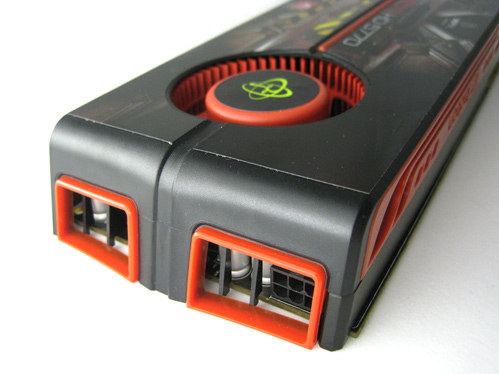
The fan is pretty quiet and the card produced less noise than the HD 5850. The picture below shows the two new HD 5700 cards.
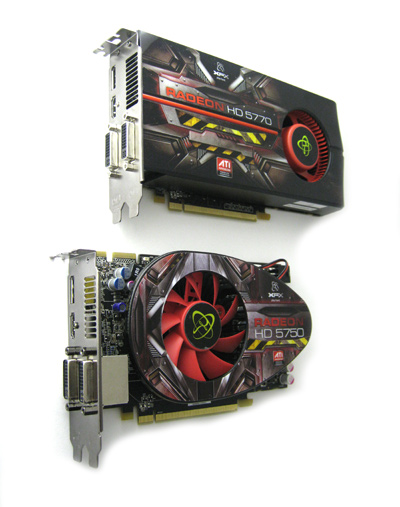
XFX HD 5850
The HD 5850 is based on the same Cypress GPU like the HD 5870, it has the same GDDR5 memory and supports all the features its bigger brother has. XFX's card uses reference desing, and the card comes with a coupon for the game Dirt 2.
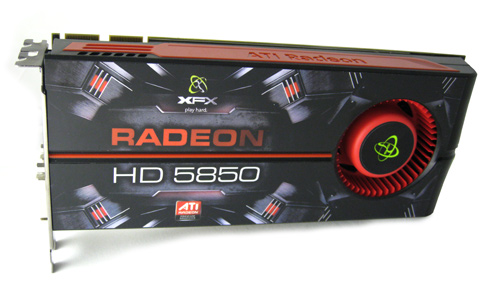
The GPU runs at 725MHz and the 1024MB of GDDR5 runs at 1000MHz. All the memory is located on the GPU side of the PCB, and unlike the pricier HD 5870, there's no backplate. The cooling is dual-slot and does a great job without making too much noise, as temperatures rarely exceed 80 degrees Clesius. The highest temperature we measured on the HD 5850 was 85 degrees Celsius, but those were measured in the most intensive tests.
The card uses GDDR5 memory of higher quality than on the HD 5700 series, and we're talking about Samsung's K4G10325FE-HC04 memory rated at 1250MHz (5000MHz GDDR5 effectively).
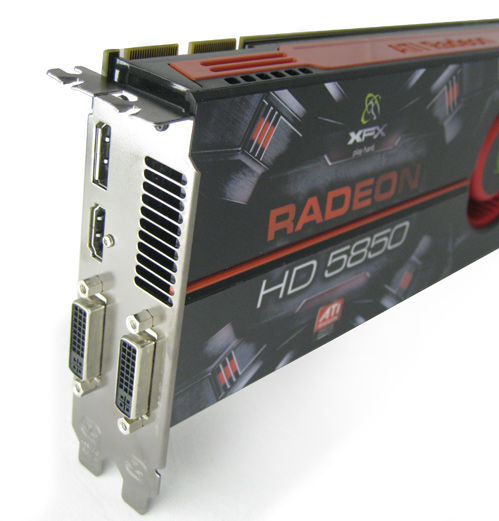
The box puts an emphasis on the ATI Eyefinity technology. Appart from the option to chain up to three monitors on one card, the HD 5850 allows for using them as one monitor with a higher resolution spread across three monitors. The card comes with two dual-link DVI outs, one HDMI and one DisplayPort video out.
The card requires two 6-pin power connectors.
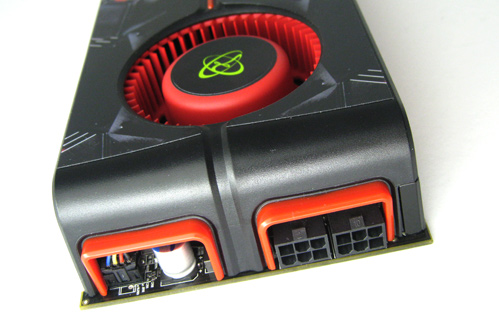
All our today's XFX cards came in identical packaging, but with different emphasis points of course. All the cards have XFX 5-star support and the HD 5850 puts an emphasis on the Dirt 2 gift-game.
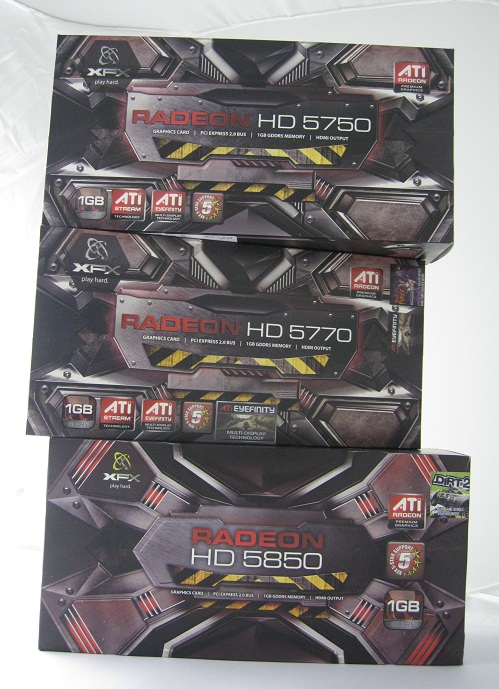
TestBed
Motherboard: MSI P45D3 Platinum ( Provided by: MSI );
Processor: Intel Core 2 QX9770 Extreme edition at 3.6GHz ( Provided by: Intel );
Memory: Corsair Dominator 12800 7-7-7-24 ( Provided by: Corsair);
HDD: WD VelociRaptor 300G 10,000RPM ( Provided by: SmoothCreation );
Driver: ForceWare 191.07, Catalyst CCC 9.9 Vista 32 SP1
We've recently recieved XFX's exquisite Black Edition 850W power supply which comes with the 80+ certificat, although we instantly fell for its looks and the modular design. We've been using it for a few days in our test rig and it has proven to be really good, but we'll follow up on that with a separate review.
Looking at Futuremark synthetic tests, the HD 5770 manages to hold its ground against the HD 4870, while the HD 5750 can keep up with the HD 4850.
In 3Dmark 06, the HD 5770 manages to outpace the HD 4870, albeit by a tight margin. The HD 5750 mauls the HD 4850 and scores 10 percent higher. The same goes for the HD 4770, AMD's first 40nm GPU.
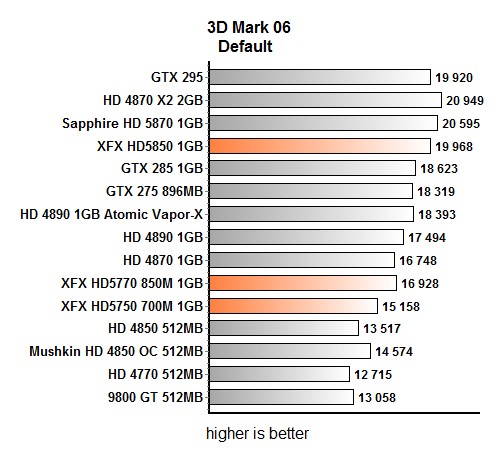
Moving along to 3Dmark Vantage on Performance settings, the HD 5770 is unable to keep up with the HD 4870, but it still stays close. HD 5750's 20
percent lead over the HD 4850 and HD 4770 melts away.
The trend continues in Vantage High, but the HD 5750 again manages to pull away from the HD 4850 and HD 4770. Once again, the Juniper XT core of the HD 5770 proves quite a match for the RV770-based HD 4870.
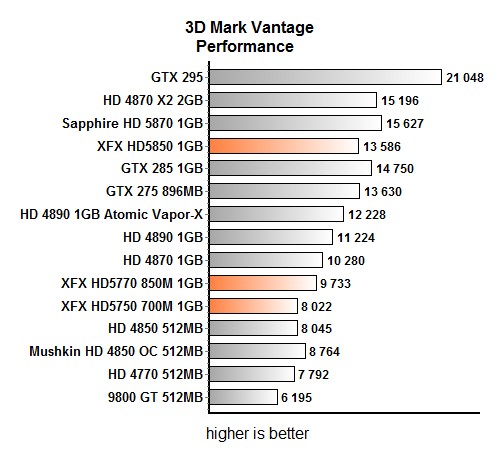
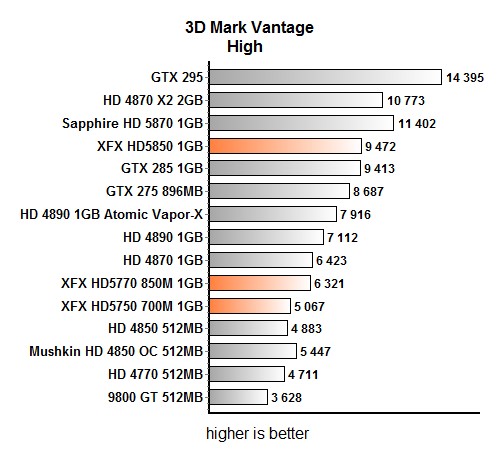
In Vantage Extreme, the Juniper cores with a higher transistor count and newer architecture prove they can keep up with previous generation GPUs,
even with a 128-bit bus. The HD 5770 scores X4369, almost the same as an HD 4870. HD 5750 manages to stay ahead of the HD 4850 and HD 4770.
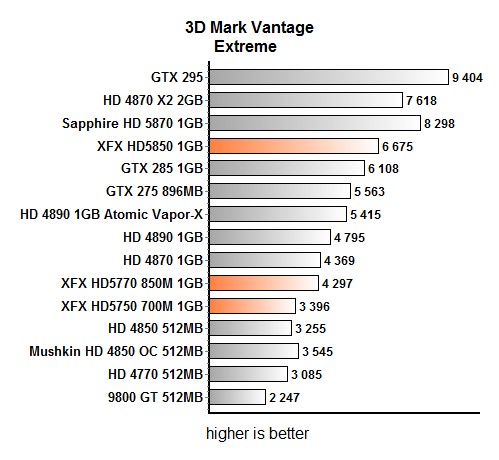
FarCry2
In Far Cry 2, the HD 5770 manages to outrun the reference HD 4870 card but only at 1680x1050 without AA. Both cards are quite capable of spinning Far Cry 2 at 1920x1200, with and without AA. Once you push the resolution up to 2560x1600 with 4xAA, both cards drop below the magical 30 frames per second mark.

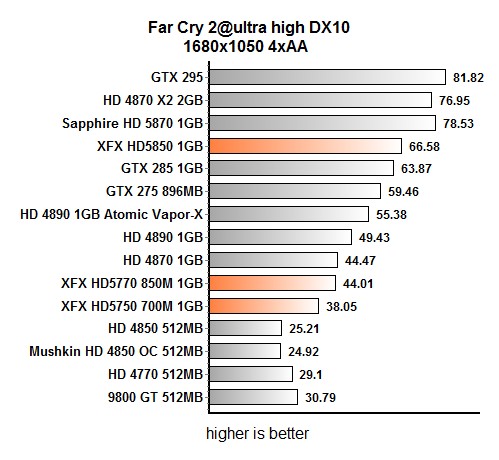
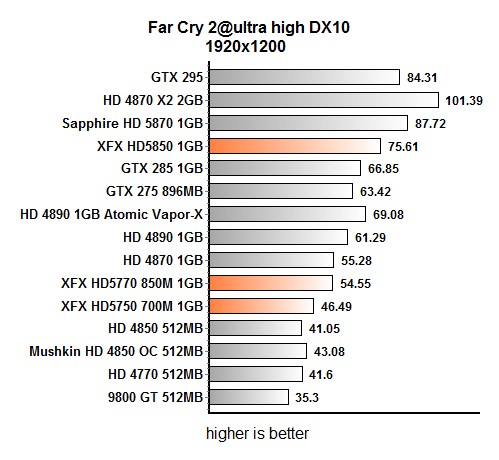
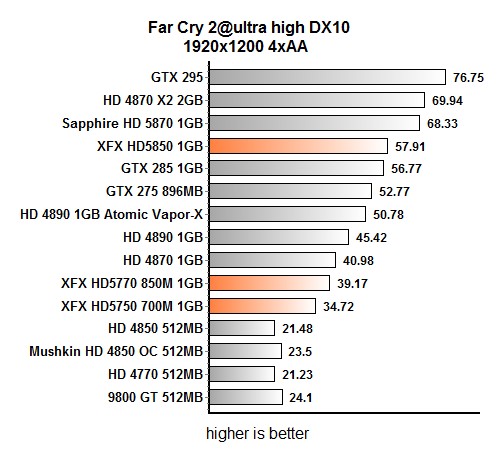
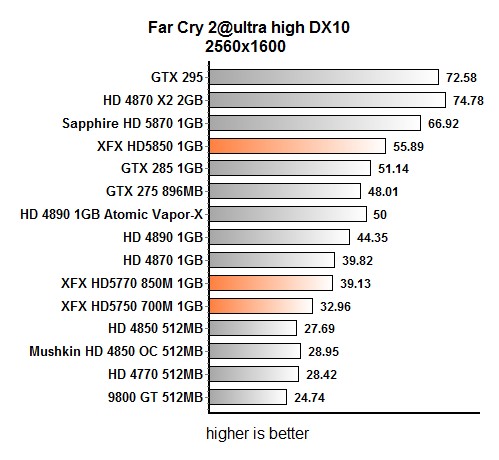
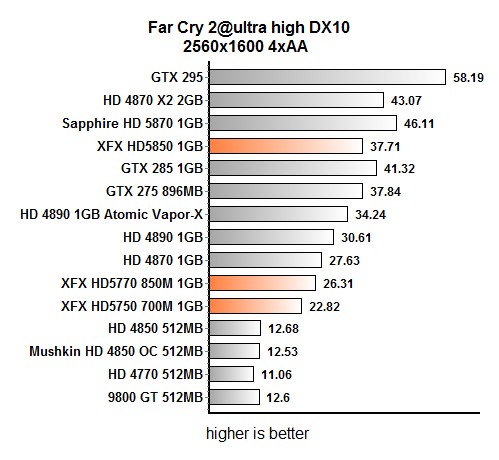
Left 4 Dead
The HD 5850 manages to outrun the GTX 285 in every single test, where the highest performance gap was around 20%. Furthermore, The XFX HD 5850 does a good job in keeping up with the Sapphire HD 5870 1GB, which is a nice feat especially considering that the highest performance difference is at 2560x1600 and 4xAA 8XAF, and the difference still amounts to 22%.
The XFX HD5750 scores almost identically to the HD 4850 512MB, lagging behind by a few frames throughout the test.
The HD 5770 does pretty well, and without the filters on, it's 4%-10% slower than the famous HD 4870. Turning the filters on results in 15%-20% difference.

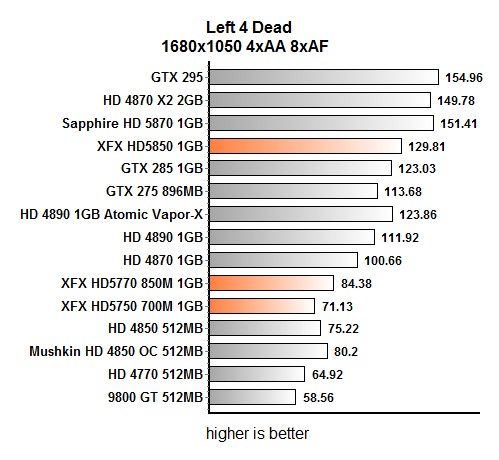
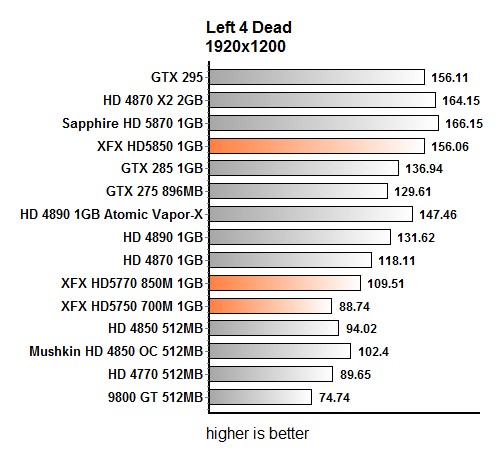
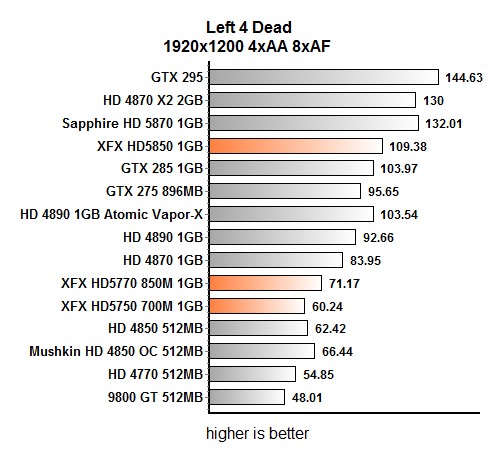
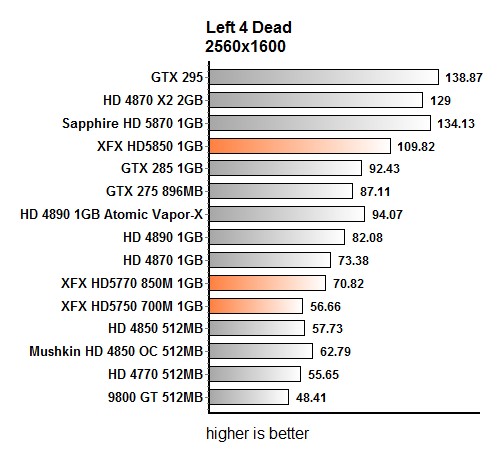
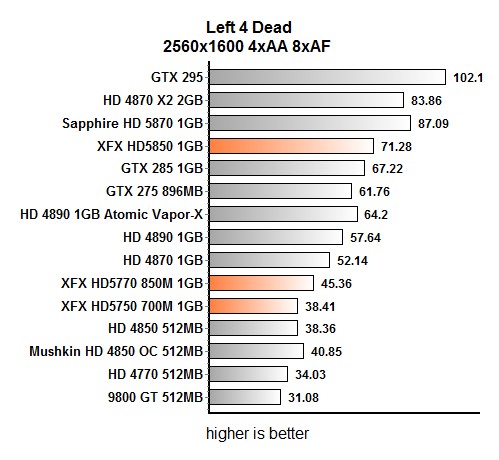
World in Conflict
The HD 5850 runs on par with the GTX 285 but it seems to lose whenever AA and AF filters are turned on. It snatches its first win at 2560x1600 but only by 2 frames, only to lose again when AA and AF come into play.
At 1680x1050 and no filters on, the XFX HD5750 beats the HD4850 512MB, the HD4770 512MB and the 9800GT 512MB but loses to Muskin's HD 4850 OC. Unfortunately, while it ran on par with Mushkin's overclocked 4850 and again outscored the aforementioned cards, the frame count in higher resolutions was below what is considered playable.
The HD5770 loses to HD 4870 but only by a couple of frames, and the worst case scenario loss is only 8 frames, which isn't too shabby.
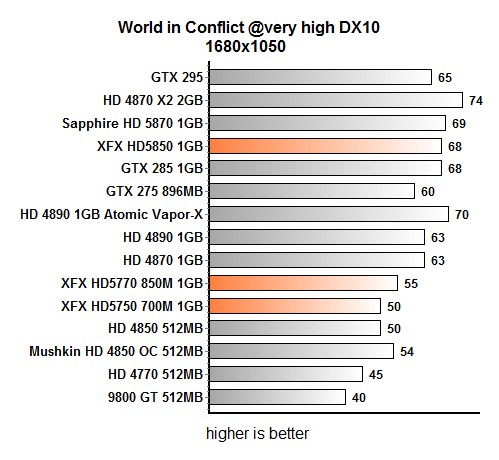
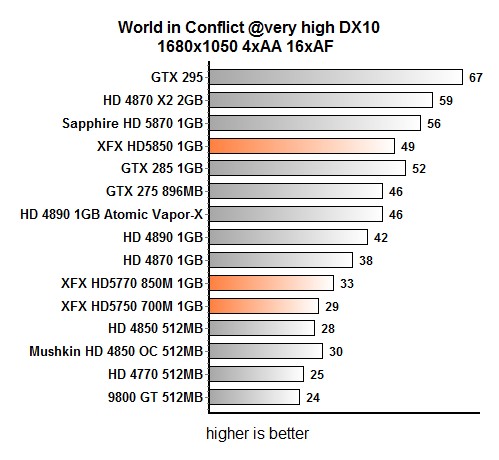
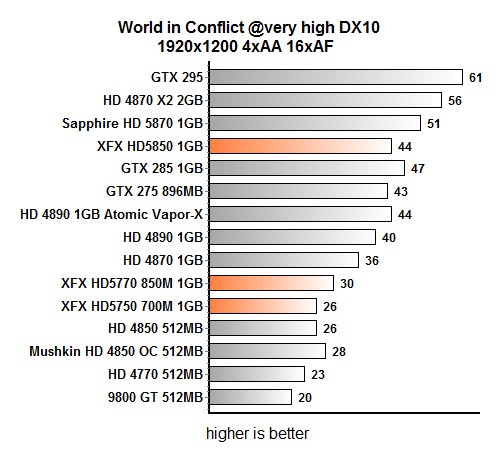
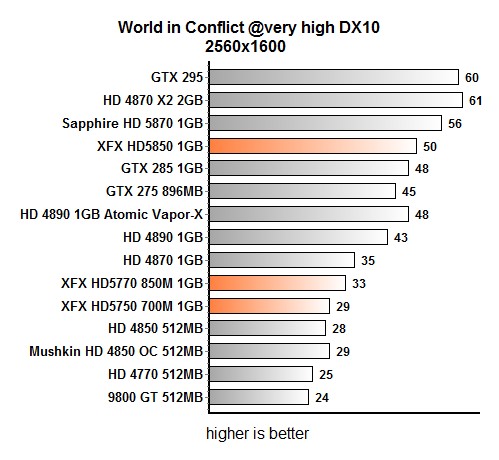
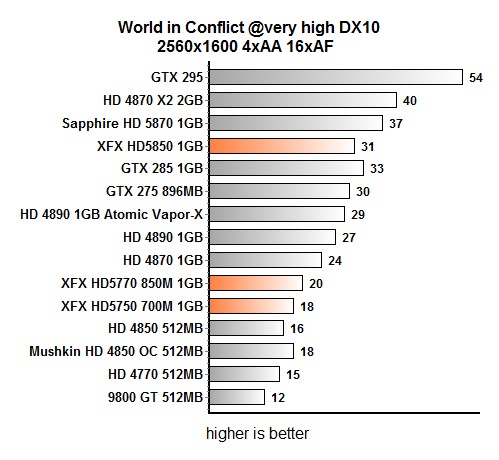
HAWX
HAWX sees the HD 5850 doing well versus the GTX 285, and while lower tested resolutions resulted in an almost identical performance, the performance gap became more evident with higher resolutions and antialiasing. At 2560x1600, the HD 5850 scrapes away a win by mere two frames, but turning on antialiasing sees the GTX 285's performance drop significantly, and the HD 5850 wins by as much as 47%.
While the HD 5750 runs in a tight pack with the reference HD 4850, Mushkin's HD 4850 OC and the HD 4770, it loses or runs on par with the reference HD 4850 all until the final resolution, which didn't matter much as it scored 29fps. Mushkin's OCed HD 4850 seems to take the cake in this one.
The 5770 lags behind the HD 4870 from 6% to 23% at all the tested resolutions, while the lowest performance difference was recorded at 2560x1600, where the HD 5770 ran about 7% slower.
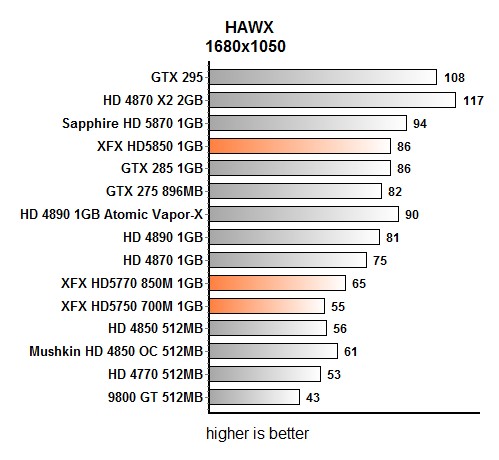
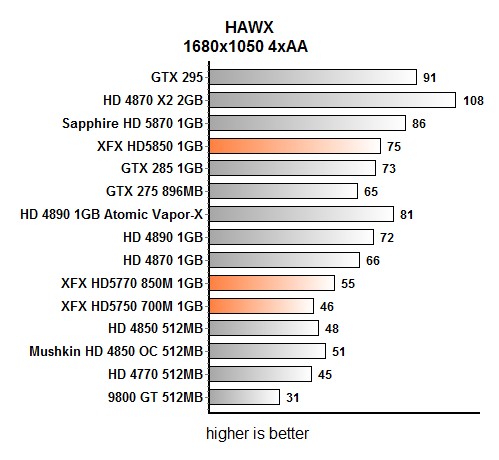
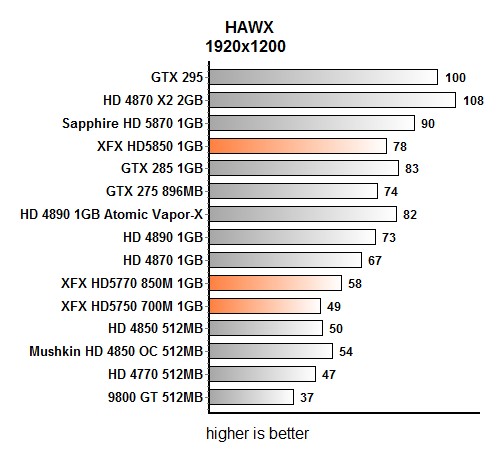
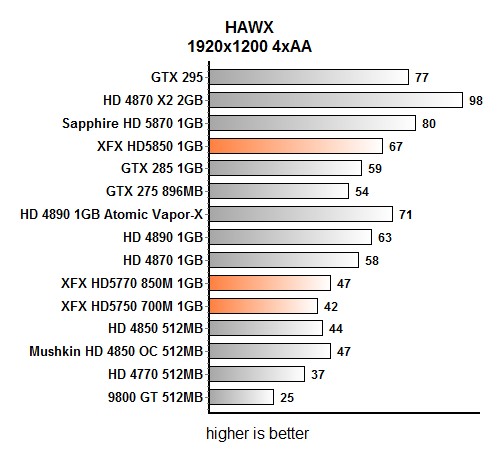

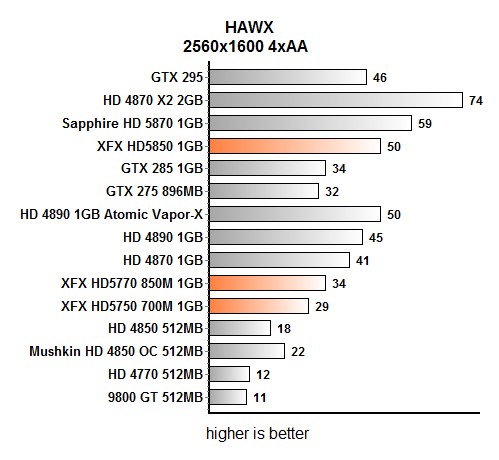
The only spec differences are a reduced shader count of 1440 (minus 10%), reduced clocks of 725 MHz core (-15%) and 1000 MHz memory (-17%). As a result the card is roughly 15% slower than the HD 5870, but costs over 40% less, making it an ideal candidate for the price/performance aware user.
Thermals, Noise
The XFX Radeon HD 5850 is almost inaudible when idle, and while it occasionally hit 82 degrees Celsius in more intensive scenarios and the cooler ran a little louder, it's still not enough to be considered noisy. Only the FurMark tests made the card hit 85 degrees Celsius, and it's only then that the fan became a bit loud, but that happened for brief moments.
AMD made sure that Evergreen cards get appropriate, quiet and stable cooling, which is a big step from the previous generation. The XFX HD 5850 ran at about 38 degrees Celsius in idle mode, and the entire rig without the monitor consumed from 80 to 88W.
With XFX HD 5770 and XFX HD 5750 in in our rig, idle consumption ducked by a couple of W, and our system consumed up to 85W. During HD 5770 testing, we measured maximum test-rig consumption of 201W. The same scenario with the HD5850 resulted in consumption of 276W whereas the HD 5750 resulted in our system consuming up to 186W.
During operation, the XFX HD 5770's temperatures climbed up to 76 degrees Celsius, whereas the HD 5750 temperatures hit up to 65 degrees Celsius.
Conclusion
ATI had a good launch of Radeon 5770 cards and the new cards with the 128-bit memory interface matched with 1200MHz memory and 850MHz core clocks proved to be a good combination. Its 40nm little brother - the Radeon 5750 is a bit slower.
All the today's cards come with dual slot cooling that runs pretty silent except on the HD 5850, which can occasionally be heard. All the Evergreen series cards come with DX 11 support and thus are great future-proof investments.Windows 7 will be out soon, and if you're planing to milk it for all it's worth, then these cards are currently the best, and only option(s).
Our today's test samples once again prove that XFX has what it takes to deliver quality products, and with the 5-Star support, you'll be set for a long, long time.
XFX HD 5770
The XFX HD 5770 is a mainstream card, but despite sharing the market segment with the HD 4870, it has a lot more to offer. Of course, this is a DX11 card as well, and while it consumes less than the previous generation at same clocks, that's not all as it brings plenty of outs as well as ATI Eyefinity support. You can find this card at Newegg, where it's priced lower than in the EU (130 euro). On the other hand, no matter where you purchase it, this card is worth every penny.
XFX HD 5750
XFX HD 5750 is currently the slowest offering to come from AMD's Evergreen generation, but it still packs enough punch for gaming at standard resolutions. It outperforms the HD 4850 and HD 4770 cards, but the price isn't quite attractive. Despite the fact that it's priced at saucy 115 euro, it seems as if all the cards are sold out already. The reason probably hides behind the fact that people want cheap DirectX 11 cards, even if they're not so cheap for what you get.
XFX HD 5850
The XFX HD 5850 is clearly on of the best cards we've had on our tests and the bang-per-buck ratio is excellent. 220 euro, which is the pricetag on XFX's HD 5850, buys you an excellent gaming card with support for AMD's latest technologies and of course - DirectX 11. If that's not enough, throw in a free game Dirt 2, and it turns into a no brainer. The card runs at reference clocks, but it's more than enough for playing any game you'd like. It's about 15% slower than the currently fastest single-GPU card, the HD 5870, but bear in mind that it's about 40% cheaper as well, which is a great deal. The golden combination of excellent performance, quiet operation and attractive pricing go a long way towards earning this card our award. Add to that the fact that this is a DX11 card which presents a great investment in the future and that it features AMD's Eyefinity, and this is a no brainer - we dub the XFX HD 5850 a Fudzilla Recommended graphics card.
